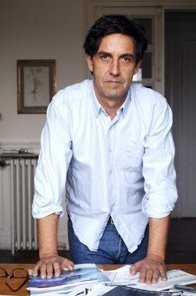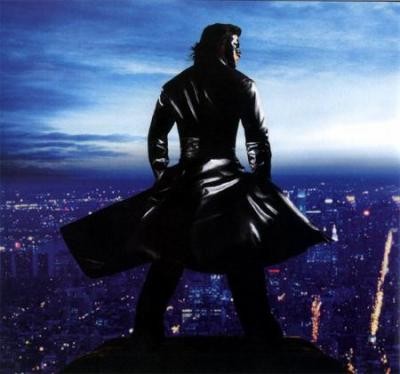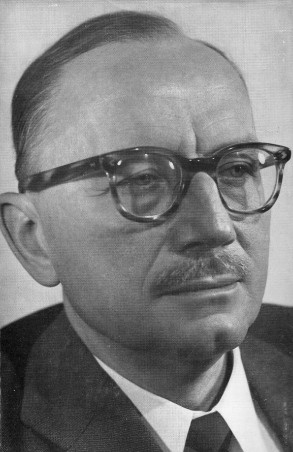A Posthumous Conversation With Arnold Gehlen
Thomas Molnar
My only "encounter" with Arnold Gehlen was on the pages of Criticon: He was the subject of the Autorenportrat in the first issue of the review; I was the subject in the second. This is not much, yet I have mentally "conversed" with him several times, thereafter as a conservative social anthropologist. I employ conservative both as a term of praise and disagreement. Facing his progressive colleagues, a conservative social philosopher is one who does not indulge in wishful imaginings that he presents as the inevitable future of mankind. At the same time, he runs the risk of becoming intellectually rigid when he assumes that man, less plastic than the evolutionists believe, is determined by successive civilizational forms, from that of the hunter-gatherers to postindustrial society.
Gehlen is part of a school of thought whose members divide history--not l'histoire evenementielle but sociotechnical history--into boxes, then shuffle their contents and are visibly annoyed when the cards from one box spill over to another box. A good illustration of this method of over classification is found in the works of the cultural anthropologist Pitirim Sorokin who involves himself in so many cross-references that the reader finally loses the line of argument and can only hold on to a few passages for their illustrative value.
In the above paragraph, I tried to unmask the scholarly processes of these men when I called their professional object "sociotechnical history." It seems to me that most, if not all, of these admirable thinkers are over impressed by our "age of technology," and have become its victims in the sense that they regard it as the end of history, culture, and the human condition. To be sure, this view may be more defensible than that of their progressive colleagues. These latter are similarly overimpressed but build temples to technology, congratulating each other that they can now pray at the same shrine, members of the same ultimate cult. Gehlen and his colleagues were less naïve; they did not like what they saw. Yet they, too, considered technological civilization as the ultimate human achievement, though perhaps in the negative sense, as if man's being turned into a machine were inscribed in the natural order of things.
History As Positive Achievement
What can one do after reaching such a conclusion? Two possibilities are left. One is given by the pessimistic historian Oswald Spengler: the replaying of the whole scenario from infancy to senility in some other geographical setting, endlessly. The fatalism of this process shuts off all discussion. The other possibility was explored by Gehlen: the explanation of our supposedly final civilizational shape as seen in reference to former ages, now perceived as approaches to the present level of mechanized living. Facing Spengler's picture of a cyclical history, Gehlen declares the course of history irreversible and, as such, a positive achievement.
The French philosopher Henri Bergson at least contemplated a pair of alternatives, one of them negative, and the other positive. The élan vital had two choices, one of which ended in the cul-de-sac of perfect but mechanized instincts (the lepidoptera); the other of which flowed in the direction of an incalculable freedom and in the direction of man--the open intelligence, the creative artist, mystic, saint. Gehlen, however, insists on basic human constants--stability, regularity, and domination over nature--and is led to such a strange rapprochement: equation between the magical practices of archaic man and modern technological inventions. In both cases, Gehlen holds, man projects his need for regularity and routing onto the outside world. Magic brings him the obedience of the organic universe (or what his animism regards as organic); governing technology brings him the scientific laws of inorganic matter.
This is, of course, reductionism of a rather materialistic kind. Marx and Engels, and before them, Helvetius and the Renaissance adepts of Epicurus, could have subscribed to it: Religion is merely a method of influencing imaginary superior forces. Once these forces are harnessed, scientific laws and their technical embodiments take over--and give us at least as much satisfaction as religion. The logic of this position does not stop here; it compels us to distinguish between our dependence on animate forces (in the age of magic) and our freedom today, as we manipulate the inanimate world. Max Weber's concept Entzauberung may be relevant here; that is, nature's desacralization as not merely an option, but an inevitable and irreversible transformation. As Gehlen writes, with man's switch from near passive object to active-dominant subject of historical and productive forces, the moral ideal has also changed. Is this not the line of argument of all utopian thinkers, from Joachim of Fiore to Teilhard de Chardin, not to mention the solid phalanx of progressive social scientist and ideologues?
A Rationalistic Future
I hope the reader sees now the nature of my objection to Gehlen's quasi-deterministic vision. It is a vision that German thinkers adopted at the end of the last century, and that they have had certain reasons to cultivate in this one. Writes Gehlen: "The future no longer holds any prospect of a resurgence of mystical consciousness, since the industrial culture now conquering the globe is rationalistic through and through" (Man in the Age of Technology, p. 122). He proceeds to analyze industrialization's dreary consequences, the bureaucratization of life, mechanization of work, and institutional dissolution. This is Max Weber and Oswald Spengler again, themselves influenced by Vico, Burckhardt, and Tocqueville, and in their turn influencing Toynbee, Ortega, and others. Gehlen is by no means along; in fact, the cultural mood he represents has become all-pervasive, a sign of the times. But no matter how many brilliant names subscribe to and illustrate this mood and trend of thought, it is no more than a vision of the world closing in upon us.
If I read Gehlen correctly, his philosophical anthropology contains two principal propositions. The first is that one may speak of culture only in a magical ritualistic sense, which suggests man views himself as a fragile being. This would also explain the human need for institutions because they mediate the sphere of transcendence to communities, at least to Gemeinschaften. And it further explains why, according to Gehlen, the place of institutions in our time is taken over by organizations (Gesellschaften). These temporary products of social relationships regulate themselves without pointing to a beyond and express ad hoc subjective desires.
Gehlen's second proposition is that the consciousness of an age alters in response to changes in culture, in the form of human settlement or method of production. In our industrial civilization, then, culture has come to an end, and our consciousness is shaped by vast, manipulated, and manipulatory forces (the media, commercial publicity, government propaganda). The small enclave, in which each of us lives his impoverished private existence, with neither gods nor genuine human contacts to console us, has no cultural motivation and is easily adaptable to a hedonistic life-style.
Although Arnold Gehlen and the other philosophers of civilization neither make excessive use of the so-called objective methods of measurement nor reject value judgments such as "decadence," "moral decline," and "social fragility," their central weakness is their inability to rise above the typological view of history. They ought to take into account the fact that every age proceeds to divide historical time according to its own convenience or prejudice, distributing praise, difference, or hostility by means of labels it nails to the various time-sections. "Middle Ages" contains a negative verdict, "Enlightenment" a positive one, while "ecumenic age" has a question mark attached to it.
No wonder, then, that our preoccupation with industry and technology has introduced and encouraged a new classification based on the ways and methods of production. This is why we discovered in retrospect the nomadic gatherers; the clans of hunters and fishermen; the settled agriculturists and animal breeders; the urban population; artisanship and trade; large-scale, indeed global, industry; then, with an anxious look at the future, the age of nuclear energy and spatial navigation. The postulate that overarches this enumeration is irreversibility. As Gehlen writes, we cannot return from the industrial to the mythical consciousness because the former destroyed the later with its cold, rationalistic methods and has expanded throughout the planet.
The Shaping Of Societal Consciousness
Where is my disagreement with Gehlen and the school to which he belongs? It is questionable to what extent the consciousness of a society is shaped by its material substratum, productive forces, and social relationships. It was the Marxist Lucien Goldman who tried (in Le Dieu cache) to demonstrate that Pascal's and Racine's work can be explained in terms of the new sociological position of the noblesse de robe--a thesis brilliantly demolished by a young scholar, Gerard Ferrey-rolles. Similar attempts at a basically Marxist analysis abound in the works of sociologists of knowledge like Karl Mannheim, and, of course, Georg Lukacs and the Frankfurt School.
Gehlen did not belong to any of these groups, yet he shares with them a number of intellectual ancestors and presuppositions. Industrial society was so traumatic for scholars holding a tradition-based worldview that some drew apocalyptic conclusions from its predominant position and gradual annexation of various areas of daily and cultural life. Let us not forget that in the nineteenth century not scholars but primarily artists opposed scientific progress (Blake, Baudelaire, Flaubert, then Pound, Yeats, Eliot); most intellectuals were swept off their feet by the prospect of utopia, but art historians soon joined the artists in their opposition to technology and mechanization (Sedlmayr, Ortega, Weidle).
We must, however, question the theories of civilization built on nineteenth century culture shock, and regard fully developed technological society not as the last phase of a sadly declining history, but as a dead-end street, in the sense that lepidoptera represent an exhausted biological line in Bergson's system. (This is not a general approval of his Evolution cretrice!) Ghelen was impressed by the gradual buildup of the civilizational stages from the nomadic food gatherers to the present, cybernetic era. When the nomads made fire with a flint, that act was profoundly needed; hence, it was sponsored by a god (Agni in the Hindu pantheon, Vulcanus in the Roman), and it was an organic, unremovable part of civilization. This quality of permanence integrated "fire" with theology, philosophy (from the pre-Socratics until the Stoics), the magical worldview, alchemy, mining, poetry, and images of love and passion.
Cybernetics, no matter what its giant achievements, cannot create counterparts in imagination nor install them in the pantheon. It is in the strictest sense unneeded, an embarrassing burden, a manipulative device; since nobody really wants it, it cannot catch our fancy. It is not part of the human condition. In short, there will never be a "cybernetic consciousness", only the learning by specialists of an auxiliary branch of industrial technology. No matter what sophisticated machines we build, man remains man, and machines, insofar as they enter our imagination at all, will be strange, freakish, monstrous, or ridiculous Frankensteins.
The Building Of A "Lepidopteran" World
Thus industrial civilization, which so overwhelms us today, is a Bergsonian quasi-impasse in the succession of civilizations. I mentioned that its first opponents were those nineteenth-century artists who rebelled against photography, the railroad, the grisaille of factory life, functional architecture, the smoke that defiles the air of cities--not mere Luddites but clear-sighted insurgents against mechanization. Of course, this kind of milieu created its own human type, utilitarian man, who judges beauty in terms of supermarkets and building speculation.
However, the whole thing can be diagnosed as a "lepidopteran" undertaking: Technology will simply not fuse with consciousness, it will frighten it, alienate it. The machine encourages things like the Centre Pompidou; it may even reach a kind of apotheosis in a night skyline mirrored in the river, as the illuminated cubes of Manhattan. Such a vista is impressive, but it does not speak to the emotional roots where time, exaltation, awe, and humility enter into alchemic combination.
Like many of his colleagues, Gehlen feared, in fact, the end of history, a typical and understandable rightist response to the present dehumanization and vulgarity of bureaucracy and mass culture. An abundance of histories of civilization has been written in the last hundred years. The authors either spoke openly of the decadence of the West or tried to balance Western civilization on the point of a needle, guessing whether it would remain or fall. At any rate, the authors believed they were publishing the last book before the end of the world, an end to come in an apocalypse or a whimper, as T.S. Eliot suggested. The books themselves were conceived on the model of inventories, the last tour d'horizon before all books are closed.
Yet, history continues, and it is not irreversible. Indeed, irreversibility itself is a mechanical concept, exemplified by the machine that never stops functioning. But how could we say of Chartres or a Mozart symphony that it is irreversible, or that Augustine and Michelangelo did forever? Such statements, we know deep inside, do not make sense. Likewise, we know that a mechanical product, like the Centre Pompidou, regardless of how long it stands, will not be assimilated by historical consciousness.
The modern reductionist methodology is responsible for Gehlen's pessimism about civilizations. It may be tempting and spectacular to equate archaic magic with the mathematical certainties derived from scientific technology, but it is a false equation. Magic was not solely an attempt to secure desired results--it suggested that the cosmos is one totality, the unimaginably vast scene of cross-influences by all its myriad components, human and other. Even when the magician obtained negative or no results, he felt the safety of belonging to a meaningful whole.
The contemporary engineer has no such support. Our civilization, built on a "second nature" as it were, cannot be intimately ours. We will leave it behind and proceed to new configurations in the light of which dehumanizing technology and its computer brain may again appear as marginal--abandoned by post-technological man. Industrial society does not have to be followed by "more of the same"; envisioning the next civilization postulates is not in our power.
The Argument For Divine Censorship
A final point. Gehlen expected, like many modern thinkers, that mankind would formulate a new, sound moral relationship with industrial culture. This may take the form of an "ethics of responsibility" (Hans Jonas) inspired by ecological considerations, a new awareness of our growing and perhaps unlimited power over nature. It must be noted, however, that morals are not formulated and observed in vacuo; they are creations of an ontological penetration into the universe by which human relations, too, are seen in a new light.
Even if we accept the classification of previous historical epochs as sedentarization, agriculture, city building, and so on, it is obvious that each presented itself under the sponsorship of divinities who fulfilled two essential civilizational functions: They offered their followers a meaning of, and justification for, what gods and men were doing, thereby suggesting myths, rituals, and art forms. Their second function was setting the limits that the given technical instruments were unable to transcend--unless the gods themselves changed, but that act created another civilization.
No such relationship exists between the technological age and what I have called the ontological penetration. Science has cleared the cosmos of the sacred presence; technology simply fills the empty place thus left, the way chairs fill the stage in Ionesco's Les Chaises: relentlessly, endlessly, even after the curtain falls. In other words, for a morality to exist as an active agent, the universe must have a meaning, and therefore techne must have limits. As if he had anticipated Hans Jonas' call for an "ethics of responsibility", Gehlen warned that Western man has had two centuries of conditioning in an uncritical admiration of technology. I think we must go farther and realize that we do have a system of ethics adjusted to science and technology, just as we have a system of esthetics. The trouble is that both are false: "Technological esthetics" is represented by the Centre Pompidou, while "technological ethics" is contained in the phrase, What is technically feasible is also moral. Neither system harmonizes with man's deeper vision of himself and the world.
Thus my final disagreement with Gehlen can now be summarized. If there were a law according to which a new and different moral vision must coincide with every major change in technology, then the weight of importance in spiritual anthropology would have to shift from the moral demand as such to what technology can offer. In short, technology would determine morality, and anthropologists would merely register this fact. This is a fashionable view, which recently found a brilliant expression in Le desenchantement du monde, by Marcel Gauchet. The French writer's work is predicated on an also fashionable "historical entropy": We have left the religious worldview behind and have descended, as if from the mountains to the endlessly stretching plain, onto a self-regulating society.
However attractive this thesis may appear, it is merely speculation for people ideologically committed to the infrastructure/superstructure process of history: With changes in the material and psychological preconditions, moral truth also shifts in a predetermined direction. But how do we measure the ratio that exists between, let us say, the structure of production or ownership, and the moral judgement? To my knowledge, there is no formula for the calculation of such a ratio, and speculation about the existence of one is the fading legacy of nineteenth-century positivism. There is thus no demonstrable relationship between infrastructure and superstructure, to use these loaded terms. The freedom and specificity of man--and if we do not postulate them, we might as well abandon all thought of an anthropology--are ultimately not tied to his material condition. Otherwise, given the present state of civilization, this "conversation with Arnold Gehlen" could not take place or would be without meaning.
Thomas Molnar is professor of religion at Yale. He is the author of The Pagan Temptation; The Decline of the Intellectual; Sartre: Ideologue of Our Time; and God and Knowledge of Reality.
[The World and I (New York), November, 1989]





 del.icio.us
del.icio.us
 Digg
Digg


